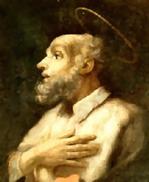Catholic Activity: Nameday Ideas for the Feast of St. Luke the Evangelist
DIRECTIONS
The apostles were called by our Lord to be witnesses of Him and to preach the gospel. They are Sts. Peter and his brother Andrew; James the Greater, and his brother John; Thomas; James the Less and his brother Jude (Thaddeus), cousins of Jesus; Philip; Bartholomew; Matthew; Simon Zelotes; and Matthias, who took the place of Judas. The New Testament includes Paul, Barnabas and others, and these with St. Luke are celebrated as apostles liturgically (but Luke is not mentioned in the Canon of the Mass).
Donald Attwater in A Catholic Dictionary says: "The apostles were the first bishops of the Christian Church. Through them the bishops have ever since had the divine commission to teach all men and govern the Church in union with the representative of their chief, St. Peter, and the God-given power to confer the sacraments necessary to the salvation of souls and the continuance of the Church."
Each apostle has a traditional symbol of ancient origin which is recognized all over the world. Examples of the shields of the apostles with their symbols may be seen in the great Catholic cathedrals and even in non-Catholic churches. An excellent example of modern symbolism is The Twelve Apostles in the Church of Our Lady of Sorrows, South Orange, New Jersey. Concordia Lutheran Seminary in St. Louis, Missouri, has a set of apostolic shields in stone which are among the best in America. Those carved over the main door of the First Baptist Church in Pittsburgh and in the Presbyterian Church in lndianapolis are also excellent. These are mentioned to assist Catholics in mixed marriages to answer objections to the symbolism connected with the saints.
To celebrate the feasts of the apostles we acquired a huge red candle made in Germany from an ancient Swedish mold. It bears the image and the symbol of each apostle. We light the candle on our dining room table on their feasts. The candle is expensive but will last for years (from LAS, see Abbreviations).
Symbols of the four evangelists can be traced to the beginning of the Christian era. The symbols most frequently met with are the four winged creatures mentioned in the Book of Ezechiel, as well as in the fourth chapter of the Apocalypse: a man, lion, bull, and eagle.
In the vision of Ezechiel these four living creatures formed the chariot upon which God rode at will over the earth; similarly Christ and His gospel are borne throughout the world by the four evangelists. Each of the chariot-bearers represented the acme of an attribute: wisdom, awe-inspiring fear, might, swiftness. But He who sat in the chariot borne by such creatures, He Himself must possess these attributes in an infinitely perfect degree. The gospel of Jesus is consummate wisdom, power, awe-inspiring and swift to accomplish its purpose of judgment unto good and evil. The traditional symbols for the evangelists retain their genuine significance when understood in this Biblical context.
St. Luke, a Greek physician and a Gentile (Col. 4:1-2), became a fellow-worker of St. Paul and remained with him until the great Apostle's martyrdom. Author of the third Gospel, Luke wrote the full account of the incarnation; he also wrote the Acts of the Apostles.
Father: The Lord and King of apostles.
All: Come, let us adore.
Father: Let us pray. We beseech You, O Lord, grant us to be aided by the prayers of St. Luke, Your evangelist, who for the glory of Your Name ever bore in his body the mortification of the Cross. Through Christ, our Lord.
All: Amen. Christ conquers, Christ reigns!
The winged ox is St. Luke's attribute because of his emphasis upon the sacrificial aspects of our Lord's atonement, as well as upon His divine priesthood. The ox was a sacrificial animal of the Jews.
Dessert and decorations. The traditional book cake inscribed with the words Verbum Dei manet in aeternum (God's Word lasts forever) would teach children that the Gospel of the inspired evangelist will continue forever upon the earth. Decorate the cake with a small ox statue or icing decoration.
Activity Source: My Nameday — Come for Dessert by Helen McLoughlin, The Liturgical Press, Collegeville, MN, 1962






